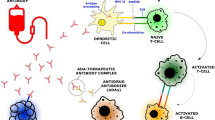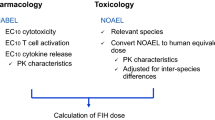Abstract
In the clinical setting, anti-drug antibodies (ADA) against biotherapeutics can influence patient safety and interfere with product efficacy. High immunogenicity has been addressed in clinic by concomitant immune suppression, such as co-administration of methotrexate with enzyme replacement therapy (ERT) and combination tacrolimus/sirolimus treatment for prophylaxis against organ transplant rejection. This study investigates the use of such immune suppressants in mitigating ADA responses to a fully human monoclonal antibody (mAb1) in preclinical animal studies. Three groups of Sprague Dawley rats (n = 18) were treated with low (0.01 mg/kg), moderate (50 mg/kg), or high (300 mg/kg) doses of mAb1. Experimental groups also received either methotrexate or tacrolimus/sirolimus immune suppressive regimens. ELISA-based methods were utilized to measure and characterize ADA and mAb1 pharmacokinetics (PK). Results demonstrated a stepwise increase in immunogenicity with mAb1 dosage. Methotrexate significantly lowered incidence of anti-variable region antibodies at moderate mAb1 dose (P < 0.05), while tacrolimus/sirolimus did likewise at moderate and high doses (P < 0.01) of mAb1. Except for low-dose mAb1 + methotrexate, all immunosuppressed groups displayed more than a 70-fold decrease in ADA magnitude (P < 0.05). This abrogation in ADA response correlated with more mAb1 in circulation by week 4 for moderate- and high-dosed mAb1 groups. These data provide an approach to mitigate preclinical immunogenicity by the use of immunosuppressant regimens. Such preconditioning can support preclinical drug development of human therapeutics that are antigenic to animals. Similar approaches could be investigated for wider application to novel therapeutics.



Similar content being viewed by others
References
Chirmule N, Jawa V, Meibohm B. Immunogenicity to therapeutic proteins: impact on PK/PD and efficacy. AAPS J. 2012;14(2):296–302.
Krishna M, Nadler SG. Immunogenicity to biotherapeutics—the role of anti-drug immune complexes. Front Immunol. 2016;7:21.
Kloks C et al. A fit-for-purpose strategy for the risk-based immunogenicity testing of biotherapeutics: a European industry perspective. J Immunol Methods. 2015;417:1–9.
Yin L et al. Therapeutic outcomes, assessments, risk factors and mitigation efforts of immunogenicity of therapeutic protein products. Cell Immunol. 2015;295(2):118–26.
EMEA. Guideline on immunogenicity assessment of biotechnology-derived therapeutic proteins. E.M. Agency, Editor. London; 2007.
EMEA. Guideline on immunogenicity assessment of monoclonal antibodies intended for in vivo clinical use, in EMA/CHMP/BMWP/86289/2010. E.M. Agency, Editor. London; 2012.
FDA. Guidance for industry: immunogenicity assessment for therapeutic protein products. C. U.S. Department of Health and Human Services, CBER, Editor. 2014: Silver Spring, MD 20993.
Jiskoot W et al. Mouse models for assessing protein immunogenicity: lessons and challenges. J Pharm Sci. 2016;105(5):1567–75.
van Helden PM et al. Maintenance and break of immune tolerance against human factor VIII in a new transgenic hemophilic mouse model. Blood. 2011;118(13):3698–707.
Brehm MA et al. Generation of improved humanized mouse models for human infectious diseases. J Immunol Methods. 2014;410:3–17.
Valbonesi M et al. Plasma exchange and immune complex diseases: the predictability of immune complexes removal to clinical response. Vox Sang. 1982;42(1):27–32.
Joseph A et al. Immune tolerance induction to enzyme-replacement therapy by co-administration of short-term, low-dose methotrexate in a murine Pompe disease model. Clin Exp Immunol. 2008;152(1):138–46.
Messinger YH et al. Successful immune tolerance induction to enzyme replacement therapy in CRIM-negative infantile Pompe disease. Genet Med. 2012;14(1):135–42.
Moss AC, Brinks V, Carpenter JF. Review article: immunogenicity of anti-TNF biologics in IBD—the role of patient, product and prescriber factors. Aliment Pharmacol Ther. 2013;38(10):1188–97.
United States., United States. Animal and Plant Health Inspection Service., and United States., Animal Welfare Act and animal welfare regulations; 9 CFR Parts 1, 2, and 3. Vol. 54. 2005, Washington, D.C.: U.S. Dept. of Agriculture, Animal and Plant Health Inspection Service. x, 136 p.
Clark JD et al. Special report: the 1996 guide for the care and use of laboratory animals. ILAR J. 1997;38(1):41–8.
Fealy MJ et al. Efficacy of rapamycin and FK 506 in prolonging rat hind limb allograft survival. Ann Surg. 1994;219(1):88–93.
Sakanoue M et al. Tacrolimus, a specific inhibitor of calcineurin, modifies the locomotor activity of quinpirole, but not that of SKF82958, in male rats. Eur J Pharmacol. 2002;438(1–2):93–7.
Bautista AC, Salimi-Moosavi H, Jawa V. Universal immunoassay applied during early development of large molecules to understand impact of immunogenicity on biotherapeutic exposure. AAPS J. 2012;14(4):843–9.
Thway TM et al. Impact of anti-drug antibodies in preclinical pharmacokinetic assessment. AAPS J. 2013;15(3):856–63.
Joly MS et al. Transient low-dose methotrexate generates B regulatory cells that mediate antigen-specific tolerance to alglucosidase alfa. J Immunol. 2014;193(8):3947–58.
Joseph A et al. Transient low-dose methotrexate induces tolerance to murine anti-thymocyte globulin and together they promote long-term allograft survival. J Immunol. 2012;189(2):732–43.
Wessels JA, Huizinga TW, Guchelaar HJ. Recent insights in the pharmacological actions of methotrexate in the treatment of rheumatoid arthritis. Rheumatology (Oxford). 2008;47(3):249–55.
Kakkis E et al. Successful induction of immune tolerance to enzyme replacement therapy in canine mucopolysaccharidosis I. Proc Natl Acad Sci U S A. 2004;101(3):829–34.
Halloran P et al. Mycophenolate mofetil in renal allograft recipients: a pooled efficacy analysis of three randomized, double-blind, clinical studies in prevention of rejection. The International Mycophenolate Mofetil Renal Transplant Study Groups. Transplantation. 1997;63(1):39–47.
Blazanovic K et al. Structure-based redesign of lysostaphin yields potent antistaphylococcal enzymes that evade immune cell surveillance. Mol Ther Methods Clin Dev. 2015;2:15021.
Zhao H et al. Depletion of T cell epitopes in lysostaphin mitigates anti-drug antibody response and enhances antibacterial efficacy in vivo. Chem Biol. 2015;22(5):629–39.
Hassan R et al. Major cancer regressions in mesothelioma after treatment with an anti-mesothelin immunotoxin and immune suppression. Sci Transl Med. 2013;5(208):208ra147.
Author information
Authors and Affiliations
Corresponding author
Ethics declarations
All animal experimentation was initiated after prior approval by the Institutional Animal Care and Use Committee (IACUC) of the University of Tennessee Health Science Center and performed in accordance with the USDA Animal Welfare Act: 9 CFR Parts 1, 2, and 3 (15) and the conditions specified in the Guide for Care and Use of Laboratory Animals (16).
Additional information
Guest Editors: Alexandra Joseph, Vibha Jawa, and Shibani Mitra-Kaushik
Jonathan Herskovitz and Josiah Ryman contributed equally to this work.
Rights and permissions
About this article
Cite this article
Herskovitz, J., Ryman, J., Thway, T. et al. Immune Suppression During Preclinical Drug Development Mitigates Immunogenicity-Mediated Impact on Therapeutic Exposure. AAPS J 19, 447–455 (2017). https://doi.org/10.1208/s12248-016-0026-8
Received:
Accepted:
Published:
Issue Date:
DOI: https://doi.org/10.1208/s12248-016-0026-8




